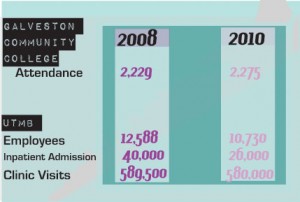Galveston branded dead city
Rose Pulido
The Signal
Two years after Hurricane Ike swept through Galveston causing billions of dollars in damage, the island is forced to defend itself due to a media blog labeling it as one of America’s top 10 dead cities.
Douglas McIntyre, editor of 24/7 Wall St. and former editor-in-chief and publisher of Financial World magazine, recently posted an article on his blog, “America’s Ten Dead Cities: From Detroit To New Orleans,” that named Galveston as number 10.
The city of Galveston discredits McIntyre’s label of being a dead city and feels targeted since recovery is still in early phases post Ike.
“This was an incorrect characterization,” Galveston Mayor Joe Jaworski said. “If [McIntyre] would have visited the city and did better research, he would have seen we have never been more alive.”
McIntyre’s interpretation of a dead city is when a loss of industry, tax base and a decrease in population can be measured.
“Galveston was chosen based on a 60 to 70 year demise,” McIntyre said. “It wasn’t germane to one incident.”
“On paper you can look at the damage but without making a trip to the island, you cannot get a good sense of the community,” said Alicia Cahill, public information officer for the city of Galveston. “I don’t think population growth is necessarily the only indicator on community vibrancy or health.”
McIntyre’s research is based on past U.S. Census Bureau and Massachusetts Institute of Technology reports where future incomes for the restoration of the city such as allocations specifically for business, housing, medical and port recovery improvements were not considered.
“We have federal and disaster funds that Congress has allocated for our infrastructure,” Jaworski said. “We will be in recovery for the next three to five years.”
The University of Texas Medical Branch in Galveston received approximately $960 million dollars in damage due to the storm causing 2,400 job terminations.
Since then, UTMB has been able to replenish a fraction of those lost jobs. However, renovations and restorations for the hospital and school are still in progress.
“The local, state and federal governments are investing up to a billion dollars to rebuild this institution,” said Raul Reyes, director of media relations for UTMB. “By the end of this year we are going to have 1000 contract workers all over the campus doing all kind of projects.”
After Hurricane Ike, residents were not allowed back on the island for approximately two weeks due to lack of electricity, gas and drinking water. Cahill explains one of the infrastructure projects the city is working on is a $75 million waste water treatment plan.
“One of the things we can do to help our citizens get back to their homes, assess their property and assess the damage, is to repair our infrastructure and put it into a commission or standard so this won’t ever happen again,” Cahill said.
McIntyre’s article also claims that Galveston’s tourism industry was set back and makes no apologies for the possibility that his argument may contribute to loss of revenue for the city.
“All the cities on the list are going to be upset because they may lose hotel reservations, but the fact is each city on the list has lost populations and the cities have shrunk,” McIntyre said.
The Hotel Galvez has been a part of Galveston’s history since the early 1900s, and is frequented by many tourists who visit the island.
“Our properties have not seen any kind of affect because of that blog on our hotel room reservations,” said Christine Hopkins, public relations manager for The Hotel Galvez. “The hotel is doing very well; we have not been impacted in that way.”
Galveston Island Convention and Visitors Bureau released a report stating hotel occupancy tax increased 20 percent in May, 34 percent in June and 32 percent in July over the same months in 2009.
James W. Little, owner of Murdoch’s, a historic business that has been part of the island for more than 100 years, said his business has increased by 12-13 percent this year.
“We’ve had the best year we’ve ever had since we’ve been in business,” Little said. “I’ve never seen crowds this good on the beach.”
Other cities listed in McIntyre’s article, in numerical order, include: Buffalo, NY; Flint, MI; Hartford, CT; Cleveland; Detroit; Albany, NY; Atlantic City, NJ and Allentown, PA. The article can be found at www.247wallst.com.
After surviving two catastrophic storms, Galveston’s community and city officials stand firm on their conviction that Galveston is a resilient city that can overcome any natural disaster or media branding.
“I encourage Douglas McIntyre to come out and visit Galveston and see for himself,” Cahill said. “We have a history of storms hitting the island, damaging the island, damaging the community, but we also have a history of picking ourselves up, dusting ourselves off and getting back to business.”



Comments are closed, but trackbacks and pingbacks are open.